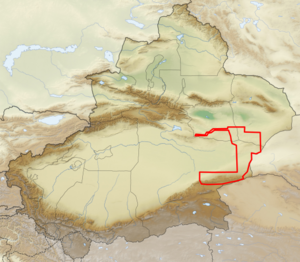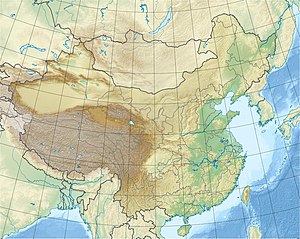| Lop Nur Wild Camel National Nature Reserve | |
|---|---|
IUCN category V (protected landscape/seascape) | |
 Lop Nur Wild Camel Reserve boundaries (in red), southeastern Xinjiang | |
| Location | Xinjiang, China |
| Nearest city | Turpan, Ruoqiang County |
| Coordinates | 41°00′N 92°30′E / 41°N 92.5°E |
| Area | 6,700,000 ha (67,000 km2; 26,000 sq mi) |
| Established | 1986 |
| Governing body | State Environment Protection Administration of China (SEPA) |
Lop Nur Wild Camel National Nature Reserve (simplified Chinese: 罗布泊野骆驼国家级自然保护区; traditional Chinese: 羅布泊野駱駝國家級自然保護區; pinyin: Luóbùpō yě luòtuó guójiā jí zìrán bǎohù qū) protects one of the three remaining habitats of the Wild Bactrian camel, a critically endangered species.[1] The reserve stretches around the north, east, and south of Lop Nur, a dry lake in a desert known as the "Sea of Death", and one of the most arid regions in the world. The reserve was established in 1986 by Xinjiang Uyghur Autonomous Region, and has been modified over the years. The reserve is under pressure from new roads in the area, development of mining interests, and illegal hunting.[2][3]
The area was formerly used as China's nuclear test site. The nuclear testing caused no apparent ill effects on the camels, which continued to breed normally. After China signed the Comprehensive Test Ban Treaty in 1996, the camels were reclassified as an endangered species.[4] Since then, human incursions into the area have caused a sharp drop in the camel population.[5]
- ^ "Lop Nur Wild Camel National Nature Reserve". Wild Camel. Wild Camel Protection Foundation. Retrieved 5 November 2016.
- ^ "Lop Nur Wild Camel National Nature Reserve". GlobalSpecies.org. Retrieved October 1, 2016.
- ^ "Lop Nur Wild Camel National Nature Reserve". ProtectedPlanet. Archived from the original on November 7, 2016. Retrieved October 1, 2016.
- ^ Hare, J. (2008). "Camelus ferus". IUCN Red List of Threatened Species. 2008. doi:10.2305/iucn.uk.2008.rlts.t63543a12689285.en.
- ^ "'New' camel lives on salty water". 6 February 2001.
